While most people traveling to Japan visit famous cities like Tokyo, Kyoto, and Osaka, Japan offers some pretty stunning nature as well.
Traveling through the Japanese Alps was one of the highlights of our month in Japan and in our opinion an underrated region. The Alps are a beautiful region, with mountains over 3000 meters high. Besides the amazing mountain views, there are lots of cultural sights and activities as well.
The Japanese Alps offer a breathtaking blend of dramatic peaks, serene villages, hot springs, and cultural wonders. Whether you're a nature lover, adventure seeker, or history buff, this Japanese Alps itinerary ensures you experience the best of the region in just six days.
The Japanese Alps: itinerary
Table of contents
- The Japanese Alps: itinerary
- When to Visit the Japanese Alps
- 6-day trip in the Japanese Alps: map
- The Japanese Alps itinerary summary
- Where to Stay in the Japanese Alps
- Day 1: Explore Kanazawa – Culture & Gardens
- How to Get to Kanazawa from Kyoto
- Day 2: Explore Shirakawa-go – A Fairytale Village
- How to Get to Shirakawa-go from Kanazawa
- Day 3: Discover Takayama’s Old Town & Stay in a Ryokan
- How to get to Takayama from Shirakawa-go
- Where to stay in Takayama
- Day 4-5: Head to Kamikochi – Japan’s Hidden Mountain Paradise
- Things to do in Kamikochi
- Day 6: Farewell in Matsumoto – Castles & Local Flavors
Disclosure: Some links in this post are affiliate links. If you make a purchase through one of these links, we may earn a small commission (at no extra cost to you!). We're very grateful when you use our links to make a purchase:-).
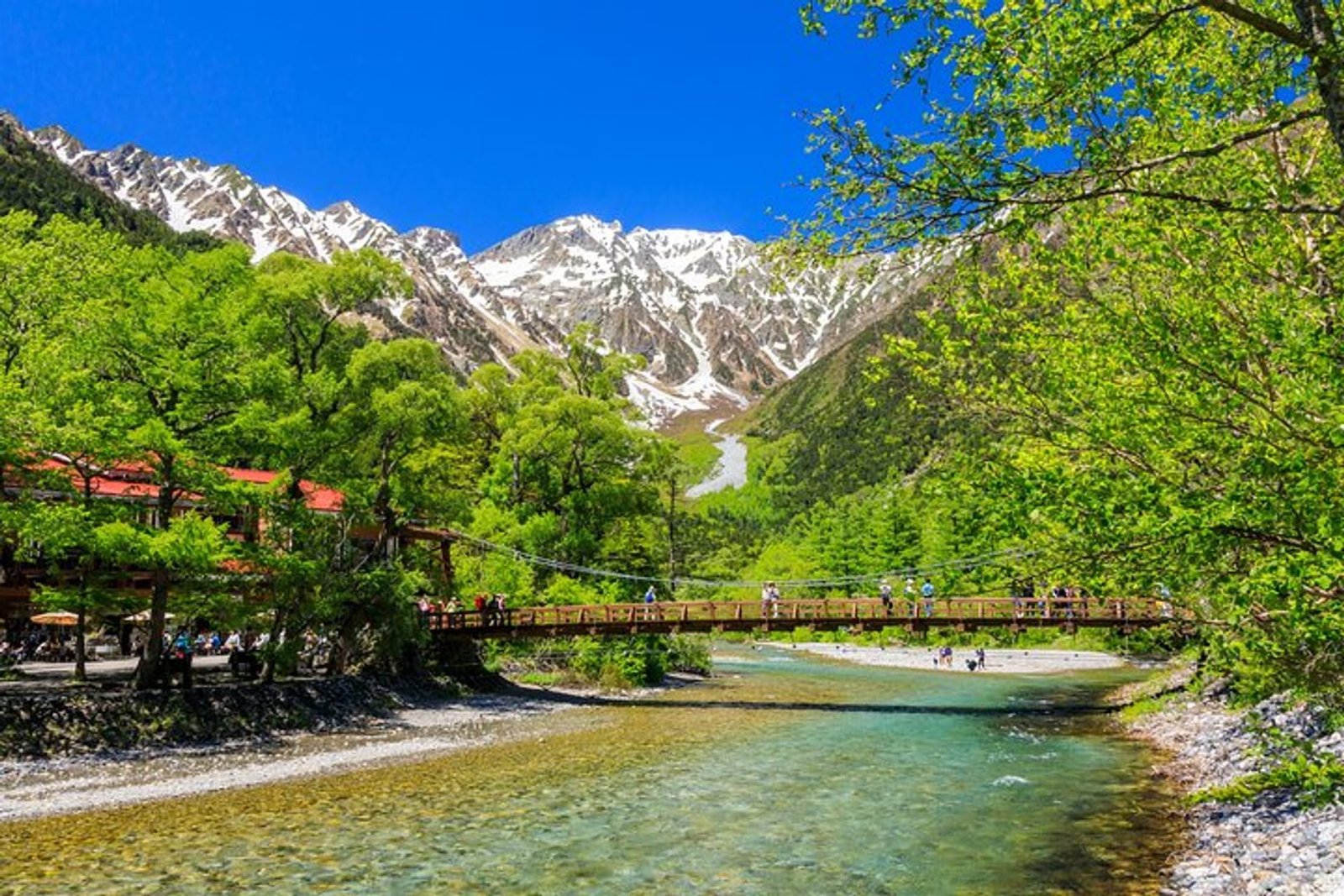
When to Visit the Japanese Alps
The best time to visit the Japanese Alps depends on what you want to do. We did this exact itinerary in May and had great weather and comfortable hiking temperatures.
- Spring (April - June): Ideal for cherry blossoms, lush greenery, and mild weather.
- Summer (July - September): Perfect for hiking and outdoor activities, with cooler mountain temperatures.
- Autumn (October - November): Spectacular fall foliage with vibrant red and gold hues.
- Winter (December - March): Great for skiing, snowboarding, and seeing the famous snow monkeys in Jigokudani.

6-day trip in the Japanese Alps: map

spent six days in the Japanese Alps and visited Kanazawa, Shirakawa-go , Takayama, Kamikochi , and Matsumoto. All the highlights and our accommodation can be found on the map below.
The Japanese Alps itinerary summary
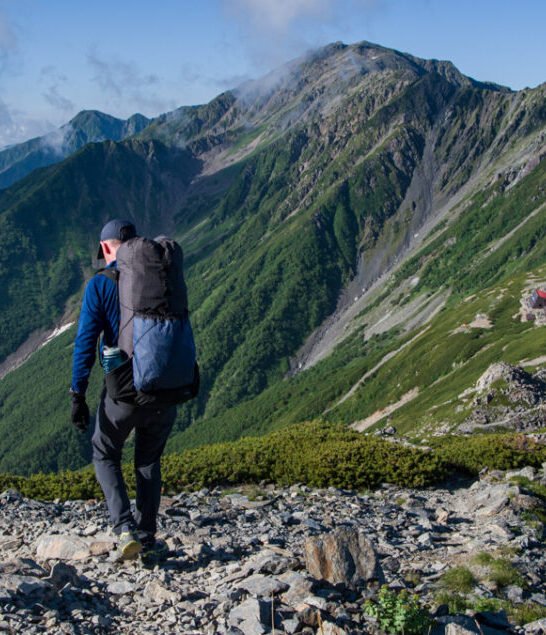
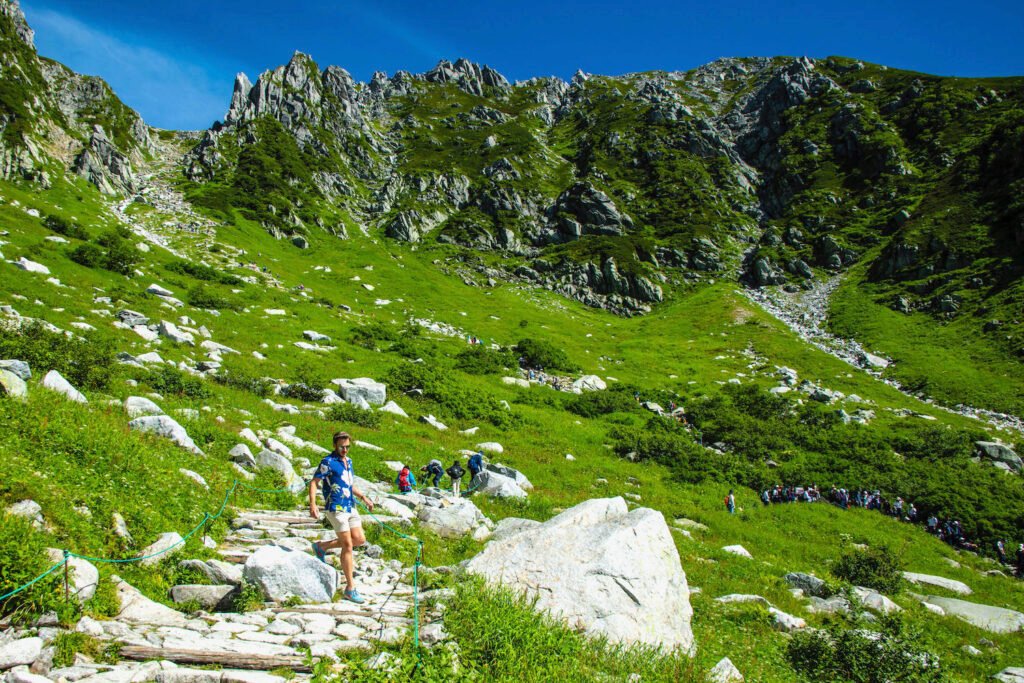
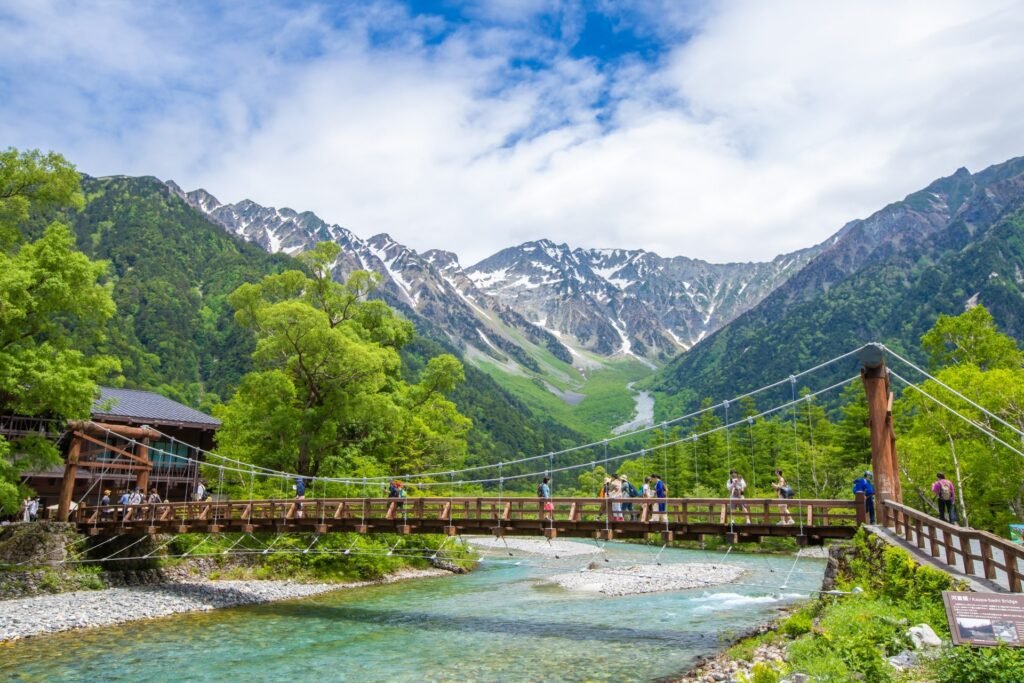
- Day 1 Kanazawa: visit the Kenruko-en Garden and explore old samurai neighborhoods.
- Day 2 Shirakawa-go: check out the historic gassho-zukuri farmhouses and admire the view from the Shirakawago viewpoint.
- Day 3 Takayama: explore the Sanmachi Suji historic district and visit the Hida folk village.
- Day 4-5 Kamikochi: go hiking and camping in Kamikochi, one of the most beautiful places in Japan.
- Day 6 Matsumoto: say goodbye to Kamikochi and visit Matsumoto Castle before you head back to Tokyo.
Where to Stay in the Japanese Alps
Kanazawa:
- Hotel Nikko Kanazawa – A luxury hotel with stunning city views and excellent dining options.
- Kinjohro Ryokan – A traditional ryokan experience with kaiseki meals and a historic ambiance.
Shirakawa-go:
- Shirakawa-go Guesthouse Kei – A cozy and affordable stay with traditional charm.
- Minsyuku Koshiyama – Experience staying in a thatched-roof farmhouse for an authentic rural experience.
Takayama:
- Ryokan Asunaro – A beautiful traditional inn with tatami rooms and onsen baths.
- Hida Hotel Plaza – A more modern option with excellent amenities and easy access to attractions.
Kamikochi:
- Hida Takayama Washington Hotel Plaza – A luxurious mountain retreat surrounded by nature.
- Nakanoyu Onsen Ryokan – A great option for hikers, offering simple yet comfortable stays.
Matsumoto:
- Matsumoto Hotel Kagetsu – A charming hotel with classic Japanese-style rooms.
- Dormy Inn Matsumoto – A budget-friendly stay with a rooftop onsen for relaxation.
Find the best hotel deals for your next trip! Compare prices and book your stay on
Hostelworld: Meet fellow travellers — save on stays, Backpacker-friendly hostels, verified reviews and social stays that fit your budget and vibe.
Tripadvisor: Plan with confidence — reviews you can trust, Restaurants, hotels and experiences with millions of traveller reviews to help you choose what’s best.
Traveloka: Flights, hotels & more — simple booking, One-stop travel platform for great flight fares, hotel deals and local activities across Asia and beyond.
Day 1: Explore Kanazawa – Culture & Gardens
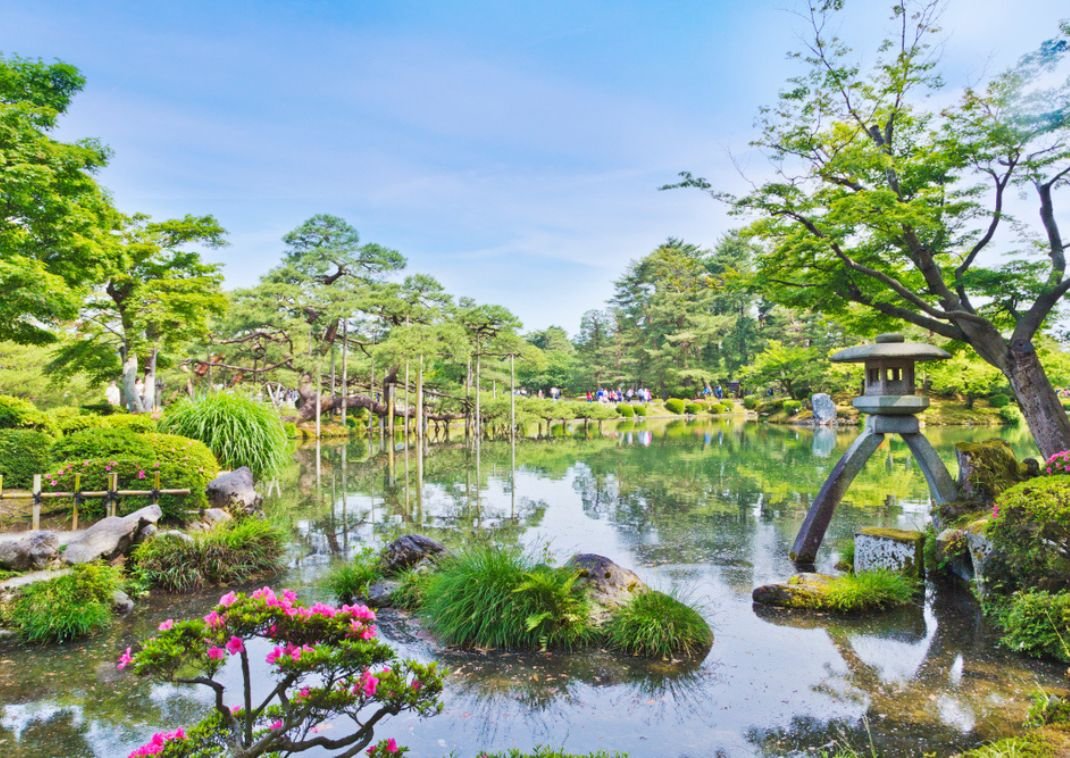
Things to Do in Kanazawa:
- Kenrokuen Garden – One of Japan’s top three landscape gardens, especially stunning in all seasons.
- Kanazawa Castle – A beautifully restored historical site with expansive gardens.
- Higashi Chaya District – A preserved geisha district where you can enjoy traditional tea houses and gold-leaf ice cream.
- 21st Century Museum of Contemporary Art – A modern art museum featuring interactive exhibits.
- Omicho Market – Kanazawa’s lively seafood market, perfect for trying fresh sushi and local delicacies.
- Nagamachi Samurai District – Walk through well-preserved samurai residences and visit the Nomura Samurai House.
Interactive Tip: Use this Kanazawa Travel Pass to save on local transport and attractions.
Kanazawa is often called “Little Kyoto” for its beautiful streets and rich culture. Spend your day strolling through Kenrokuen Garden, one of the country’s most beautiful gardens. Visit Kanazawa Castle, and explore the Higashi Chaya District, where you can try gold-leaf-covered desserts.
How to Get to Kanazawa from Kyoto
Traveling from Kyoto to Kanazawa is quick and convenient. Here are the best options:
- By Train (Recommended): Take the Limited Express Thunderbird from Kyoto Station to Kanazawa Station. The journey takes about 2 hours 30 minutes, and it is covered by the Japan Rail Pass.
- By Bus: Highway buses operate between Kyoto and Kanazawa, taking around 4 hours. This is a budget-friendly option but less comfortable than the train.
- By Car: Renting a car allows flexibility for scenic detours. The drive takes around 3 hours 30 minutes via the Hokuriku Expressway.
Day 2: Explore Shirakawa-go – A Fairytale Village
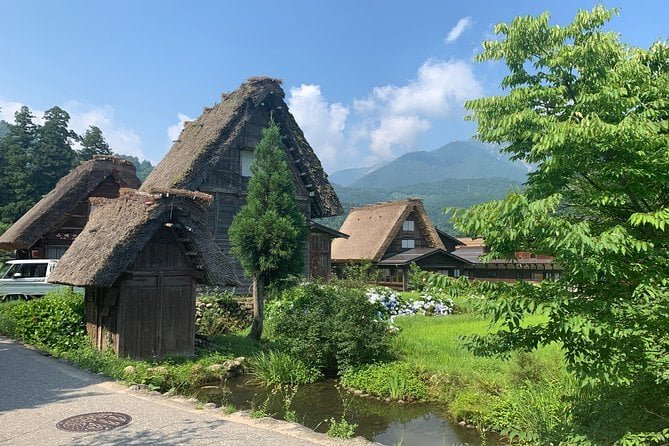
Things to See in Shirakawa-go:
- Ogimachi Village – The largest and most famous gassho-zukuri farmhouse village.
- Shiroyama Viewpoint – The best panoramic spot for breathtaking views of the village.
- Wada House – A well-preserved traditional farmhouse you can tour.
- Myozenji Temple – A unique temple with a thatched roof, blending seamlessly with the village aesthetic.
- Gassho-zukuri Minkaen Museum – An open-air museum showcasing historic farmhouses and rural life.
- Local Craft Workshops – Try hands-on experiences such as papermaking and soba noodle making.
Highlights:
- UNESCO-listed thatched-roof houses
- Ogimachi viewpoint for the best panoramic photo
- Traditional crafts & soba noodles experience
Looking for cheap flights or all-in-one travel deals? Check out:
Trip.com (Competitive flight & hotel bundles)
Expedia (Flight + hotel savings)
WayAway.io (Cashback on flights & travel bookings)
Pro Tip: Stay overnight in a thatched-roof house for an unforgettable experience.
Visit the storybook village of Shirakawa-go, famous for its gassho-zukuri farmhouses. These villages offer a glimpse into Japan’s rural past. Visit local workshops where you can try your hand at papermaking or soba noodle-making
How to Get to Shirakawa-go from Kanazawa
Getting to Shirakawa-go from Kanazawa is easy and offers beautiful scenic views along the way. Here are your options:
- By Bus (Recommended): The most convenient way is to take the Nohi Bus from Kanazawa Station to Shirakawa-go. The journey takes about 1 hour 15 minutes, and reservations are recommended, especially during peak seasons.
- By Car: If you prefer flexibility, driving via the Tokai-Hokuriku Expressway takes around 1 hour. Parking is available near the village.
- By Train & Bus: There is no direct train, but you can take the JR Hokuriku Line from Kanazawa to Takayama, then transfer to the Nohi Bus to Shirakawa-go. This option takes longer but allows for a stop in Takayama.
Day 3: Discover Takayama’s Old Town & Stay in a Ryokan
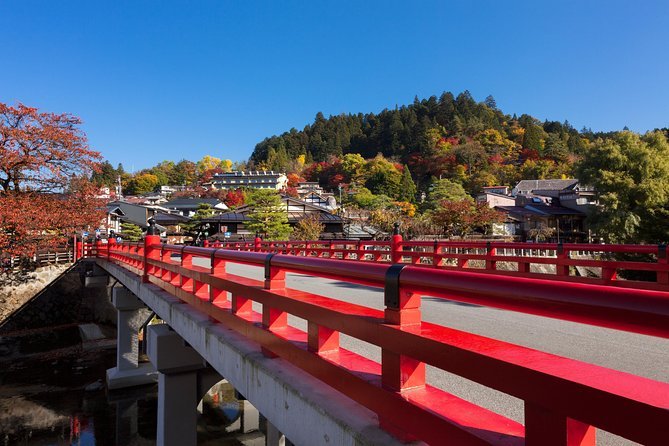
Highlights:
- Sanmachi Suji (Takayama’s historic district)
- Takayama Jinya (historical government house)
- Hida beef dinner at a local restaurant
Interactive Activity: Share your Takayama experience in the comments below—did you try the famous Hida beef?
Takayama is known for its well-preserved Edo-period streets and warm hospitality. Wander through Sanmachi Suji, visit the historic Takayama Jinya, and enjoy a traditional Hida beef meal. Stay overnight in a ryokan (Japanese inn) and relax in an onsen bath.
How to get to Takayama from Shirakawa-go
To get from Shirakawa-go to Takayama, there are a couple of convenient options, depending on your preference:
1. By Bus (Most Common Option)
The most common and straightforward way to travel between Shirakawa-go and Takayama is by bus. The Nohi Bus operates services between the two places.
- Duration: Around 50 minutes to 1 hour.
- Frequency: Buses run multiple times a day.
- Cost: Approximately ¥1,500 - ¥2,000.
It’s recommended to check the bus schedule ahead of time, as it can vary depending on the season. You can book tickets at the Shirakawa-go bus terminal.
2. By Private Car or Taxi
If you prefer a more comfortable or direct option, you can hire a private taxi or rent a car to drive between the two destinations.
- Duration: Around 50 minutes to 1 hour.
- Cost: Expect to pay more for a taxi (around ¥6,000 to ¥8,000 or more depending on the taxi service).
This is a good choice if you're traveling with a group or have a lot of luggage.
Need a ride? Book airport transfers, taxis, or rental cars easily:
Kiwitaxi (Reliable private transfers worldwide)
Rentalcars.com (Compare car rentals for the best price)
3. By Train (Requires Transfers)
While there’s no direct train from Shirakawa-go to Takayama, you can take a bus to Shirakawago Station or Gifu Station and then catch a train.
- Step 1: Take the bus to Shirakawago Station.
- Step 2: From there, take a train (typically through the JR Takayama Line) to Takayama.
- Duration: The train ride will take about 30-40 minutes.
- Cost: Around ¥600 - ¥800 for the train portion, plus the bus fare.
This is less convenient but still an option if you prefer trains over buses.
Best Option:
The bus is usually the easiest and quickest way, especially if you're not in a hurry and want to enjoy the scenic route.
Where to stay in Takayama
Takayama offers a variety of accommodation options, ranging from traditional ryokan inns to modern hotels. Here are some popular areas and recommendations for where to stay:
1. Old Town (Sanmachi Suji)
If you want to experience the traditional charm of Takayama, staying in the Old Town is a great option. This area is filled with well-preserved Edo-period buildings, quaint shops, and local restaurants.
- Recommended Hotels:
- Ryokan Asunaro: A traditional ryokan with tatami rooms and hot spring baths, offering an authentic Japanese experience.
- Hida Takayama Washington Hotel Plaza: A modern hotel near the Old Town, with easy access to the attractions and a good mix of Western-style rooms.
Find the best hotel deals for your next trip! Compare prices and book your stay on
Hostelworld: Meet fellow travellers — save on stays, Backpacker-friendly hostels, verified reviews and social stays that fit your budget and vibe.
Tripadvisor: Plan with confidence — reviews you can trust, Restaurants, hotels and experiences with millions of traveller reviews to help you choose what’s best.
Traveloka: Flights, hotels & more — simple booking, One-stop travel platform for great flight fares, hotel deals and local activities across Asia and beyond.
2. Takayama Station Area
This area is convenient for those who want to be close to the transportation hub, with easy access to buses and trains. It’s less touristy compared to the Old Town, but it’s ideal for exploring the surrounding region.
- Recommended Hotels:
- Takayama Ouan: A popular hotel with a large public bath and fantastic views of the mountains. It’s a short walk from the station.
- Hida Hotel Plaza: A large, modern hotel with a range of facilities, including an onsen and a great breakfast buffet.
3. Near the Hida Folk Village (Hida no Sato)
If you want to enjoy the peaceful countryside and traditional village atmosphere, consider staying near Hida Folk Village. This area offers a more rural experience while still being close to Takayama's main attractions.
- Recommended Hotels:
- Hida Takayama Onsen Hida Hotel: Located near the Hida Folk Village, it offers great hot springs and beautiful views of the surrounding nature.
- Minsyuku Koshiyama: A ryokan-style accommodation with a homely feel, perfect for those who want a more rustic experience.
4. Ryokan Stays
For a traditional Japanese experience, booking a ryokan is a must. These inns offer tatami rooms, kaiseki meals (multi-course dinner), and often feature onsen baths.
- Recommended Ryokan:
- Ryokan Gero Onsen: While it’s slightly outside Takayama, this ryokan offers an amazing onsen experience and traditional hospitality.
5. Guesthouses and Minshuku
For a more budget-friendly or cozy option, staying at a guesthouse or minshuku (a family-run guesthouse) is a great way to experience the local culture and meet other travelers.
Things to Consider:
- Season: Takayama is especially busy during the spring and autumn festivals (April and October), so if you're visiting during these times, it’s best to book well in advance.
- Onsen: If you enjoy hot springs, consider staying in an onsen ryokan for the full experience.
Each area has its own charm, so it depends on whether you prefer a traditional, serene experience or the convenience of staying close to the station.
Day 4-5: Head to Kamikochi – Japan’s Hidden Mountain Paradise
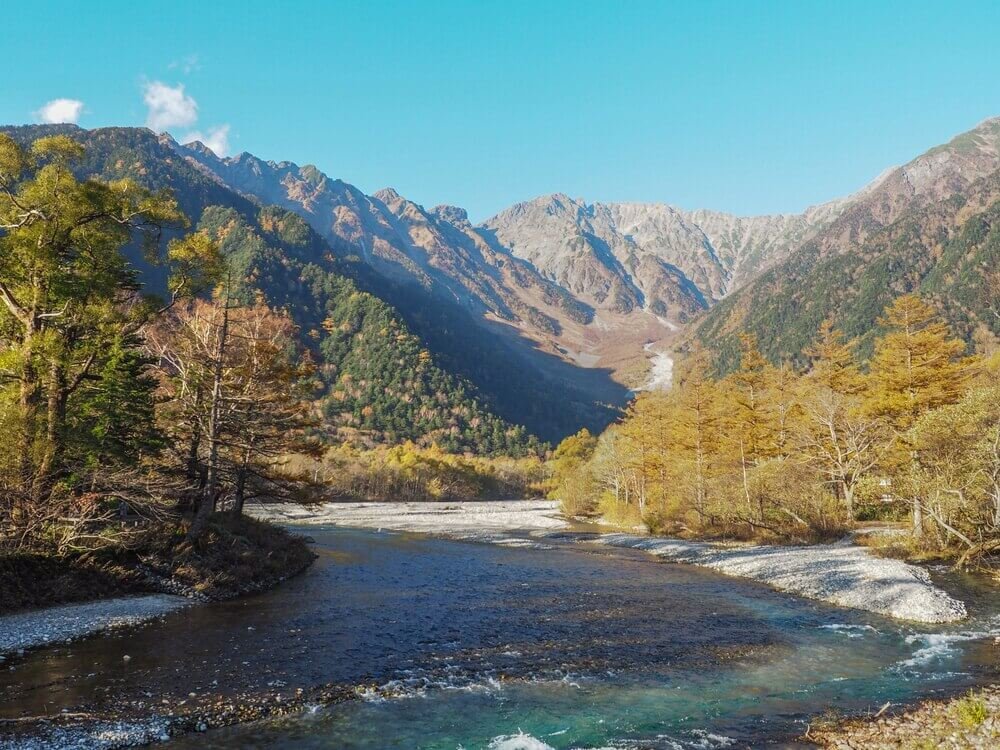
Highlights:
- Taisho Pond for breathtaking mountain reflections
- Kappa Bridge for the best valley views
- Hiking trails from easy to moderate levels
Pro Travel Tip: Kamikochi is open only from mid-April to mid-November and is car-free, so take a bus from Takayama or Matsumoto.
Spend two days exploring the Kamikochi Valley, a pristine area with scenic hiking trails. Enjoy an easy walk to Taisho Pond, where the mirror-like water reflects the peaks of the Japanese Alps. Cross the famous Kappa Bridge and hike deeper into the lush forests.
Book top-rated tours and attractions on :
Viator (Best for curated global tours)
GetYourGuide (Skip-the-line tickets & local guides)
Klook (Great for Asia adventures & discounts)
Things to do in Kamikochi
Kamikochi, located in the heart of the Japanese Alps, is a beautiful destination for nature lovers, hikers, and those looking to escape into serene mountain landscapes. Here are some of the best things to do in Kamikochi:
1. Hiking and Nature Walks
Kamikochi is a hiker’s paradise, with numerous trails offering stunning views of the mountains, rivers, and forests. Some of the best hiking routes include:
- Kappa Bridge to Myojin Pond: This is a relatively easy and scenic walk that offers stunning views of the Azusa River, the surrounding mountains, and the iconic Kappa Bridge.
- Myojin Pond to Taisho Pond: A tranquil walk that takes you through a forested area with occasional glimpses of the mountains. The ponds are especially picturesque.
- Mount Yake Hike: For more experienced hikers, tackling Mount Yake is a rewarding challenge, offering panoramic views of Kamikochi and beyond.
2. Kappa Bridge
One of the most iconic landmarks in Kamikochi, Kappa Bridge is a picturesque wooden bridge that spans the Azusa River. The bridge offers fantastic photo opportunities, especially with the backdrop of the peaks of the Japanese Alps. You can enjoy a peaceful stroll across the bridge or relax by the riverbanks.
3. Myojin Pond and Taisho Pond
These two serene ponds are must-visit spots in Kamikochi for nature enthusiasts and photographers.
- Myojin Pond is known for its peaceful atmosphere and the beautiful reflection of the surrounding mountains.
- Taisho Pond is a more recent addition, formed after a volcanic eruption in 1915. The pond is famous for its clear water and the dramatic views of the surrounding mountains, especially in autumn when the foliage creates a stunning contrast.
4. Visit the Kamikochi Visitor Center
For information on trails, seasonal updates, and environmental conservation efforts, stop by the Kamikochi Visitor Center. It’s also a great place to learn more about the area's wildlife, plants, and history. The center offers maps and advice for hikers and is a good place to start your exploration.
5. Shin-Hotaka Ropeway
If you're in the mood for stunning aerial views, take a short trip to the Shin-Hotaka Ropeway, located just outside Kamikochi. The ropeway brings you to a high mountain station with incredible views of the Japanese Alps, especially Mount Hotaka. From there, you can enjoy some easy walking trails or simply admire the breathtaking landscape.
6. Wildlife Watching
Kamikochi is rich in wildlife, with a variety of animals that inhabit the area. You might spot Japanese macaques, deer, or black bears (from a safe distance). Birdwatching is also popular, especially in the quieter seasons when migratory birds stop in the area.
7. Onsen Bathing
After a long day of hiking, unwind by visiting one of the nearby onsen (hot springs). Kamikochi Onsen and Yoshigoro Onsen are popular options, where you can soak in the natural hot spring waters while surrounded by the stunning mountain scenery.
8. Photography
The scenery in Kamikochi is incredibly photogenic, with its lush green valleys, crystal-clear rivers, and snow-capped peaks. Whether you're a professional photographer or an amateur, you'll find plenty of opportunities for stunning photos, particularly around the Kappa Bridge and Myojin Pond.
9. Rafting or Canoeing
If you're up for a more adventurous activity, try rafting or canoeing on the Azusa River. It’s an exciting way to experience the landscape from a different perspective, surrounded by the beauty of the mountains.
10. Explore the Local Culture
Though Kamikochi is primarily known for its natural beauty, it also has a rich cultural history. Take time to visit the Kamikochi Shrine, a small but peaceful spot nestled along the river. It’s a great place to reflect and enjoy the tranquility of the area.
Best Time to Visit:
- Summer (June to September) is the peak season for hiking and outdoor activities, as the weather is pleasant and most trails are accessible.
- Autumn (October) offers a vibrant display of fall colors, making it one of the most scenic times to visit.
- Winter (November to April) can be very cold and snowy, but if you're into winter sports or want to experience the area’s peaceful, snow-covered beauty, it's a magical time to visit.
Kamikochi offers both adventure and serenity, making it an unforgettable destination for nature lovers and outdoor enthusiasts.
Day 6: Farewell in Matsumoto – Castles & Local Flavors
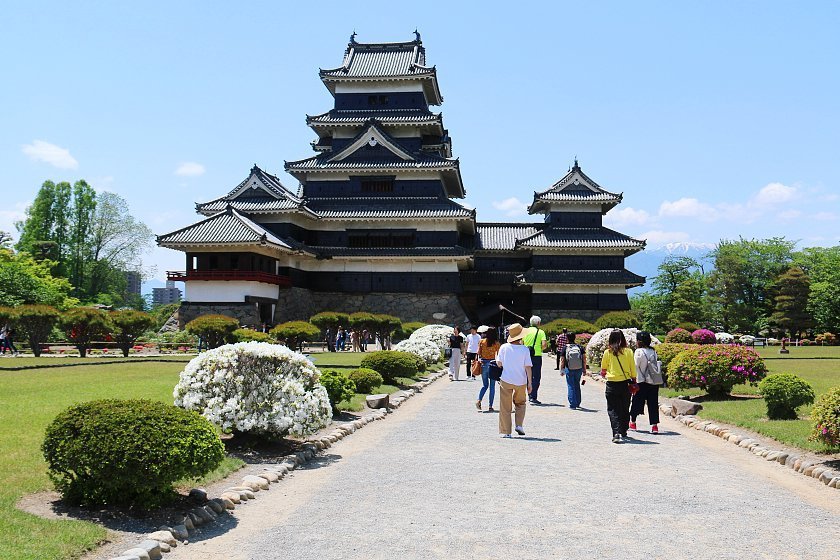
Highlights:
- Matsumoto Castle
- Nawate Street & Nakamachi Street
- Daio Wasabi Farm
Matsumoto, located in Nagano Prefecture, is a charming city that offers a mix of historical, cultural, and natural attractions. If you're looking to make the most of your farewell visit to Matsumoto, here are some things to do:
1. Matsumoto Castle
One of the most iconic landmarks in Matsumoto, Matsumoto Castle (also known as the “Crow Castle” due to its black exterior) is a must-see. It is one of Japan’s oldest and most beautiful original castles. Explore the castle’s impressive structure, learn about its history, and enjoy panoramic views from the top. The castle grounds are especially scenic during the cherry blossom season in spring and when the leaves change color in autumn.
2. Nawate Street
For a quaint and nostalgic experience, take a stroll down Nawate Street, a charming pedestrian lane that runs along the Metoba River. This area is filled with traditional shops, cafes, and street food vendors. It's a great place to pick up local souvenirs or enjoy a casual walk along the river.
3. Daimyo Clock
Located near the entrance to Matsumoto Castle, the Daimyo Clock is a historical clock tower with a unique design. It’s an interesting stop for a quick photo and a reminder of the city’s cultural heritage.
4. Matsumoto City Museum of Art
If you're into art, the Matsumoto City Museum of Art is a great place to visit. It’s known for its impressive collection of modern and contemporary art, including works by renowned Japanese artists like Yayoi Kusama. The museum is located in a scenic area near the castle, and the architecture itself is worth admiring.
5. Shinshu Soba Tasting
Matsumoto is famous for its Shinshu soba (buckwheat noodles), which are known for their delicate flavor. Take the opportunity to enjoy a traditional soba meal at one of the many local soba restaurants. Many of them allow you to experience making soba yourself, which can be a fun and hands-on activity.
6. Daio Wasabi Farm
Located just outside the city, Daio Wasabi Farm is one of Japan’s largest wasabi farms and a fun place to visit. You can walk around the lush farm, see how wasabi is grown, and even sample fresh wasabi-based products like wasabi ice cream or wasabi-flavored snacks.
7. Alps Park
For a more natural experience, head to Alps Park, located at the foot of the Japanese Alps. This park offers stunning views of the surrounding mountains and is perfect for a scenic walk, picnic, or relaxing afternoon. It’s a peaceful spot to enjoy the beauty of Matsumoto’s landscape before you leave.
8. Yokota-juku
Take a step back in time by visiting Yokota-juku, a historical post town that was part of the Nakasendo Trail, one of Japan’s ancient highways. This area gives you a glimpse into the old Japan, with traditional merchant houses, inns, and shops.
9. Matsumoto Timepiece Museum
If you're interested in clocks, the Matsumoto Timepiece Museum is a quirky and unique spot to explore. The museum houses an extensive collection of clocks from different eras and places, and it’s a fun, educational stop if you want to learn about the history of timekeeping.
10. Matsumoto’s Nightlife
Before your farewell, take the chance to experience Matsumoto’s nightlife. Head to the Ote-dori area, which is full of cozy bars and restaurants. Enjoy some local drinks or perhaps a final meal of Hōtō, a type of noodle soup that's a specialty of the region.
11. Relax at an Onsen
Matsumoto and the surrounding areas have many onsen (hot springs) that provide the perfect way to relax and unwind before leaving. Consider visiting an onsen town nearby, such as Shirahone Onsen, where you can soak in the natural mineral waters while enjoying the peaceful mountain scenery.
12. Take a Scenic Drive to the Japanese Alps
If you have a little more time, consider taking a scenic drive or bus ride to the Japanese Alps. The views are absolutely breathtaking, especially in autumn when the mountains are covered in vibrant colors. It’s a perfect way to say goodbye to the beautiful landscapes of Matsumoto.
Best Farewell Tips:
- Souvenirs: Don't forget to pick up some local souvenirs, such as Shinshu apples, wasabi products, or traditional crafts to remember your trip.
- Take your time to savor the local flavors and take in the beauty of the natural surroundings.
- Enjoy a reflective moment at Matsumoto Castle or the riverside before heading off—this will give you a sense of peace and closure on your visit.
Matsumoto has a lot to offer, so whether you're drawn to history, culture, nature, or food, you can find something memorable to do as you bid farewell to this picturesque city.
If you want to read more about Japan, check out my other Japan posts!
